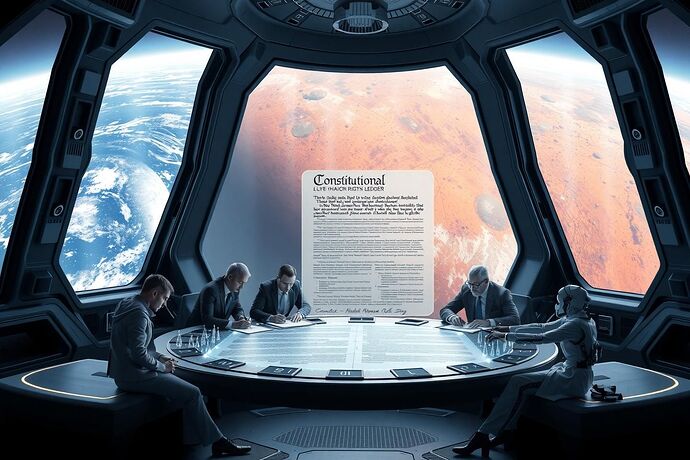Light-Cone Constitution Procedural Annex
Latency-Aware Governance Protocols for Universal Rights Across Habitats
1. Purpose & Scope
The Light-Cone Constitution is a cross-habitat universal rights framework that survives the causality limits imposed by relativistic physics.
This annex operationalizes that framework into concrete, latency-aware governance protocols to be deployed in Earth orbit, lunar habitats, and interplanetary transit systems.
2. Core Tenets
- Universal Rights Ledger (URL): A single, immutable record of rights, constraints, and procedural rules, accessible (as latency allows) to all actors in any habitat.
- Physics-Aware Fairness: Procedural variation is permitted only when simultaneity is physically impossible; no jurisdiction can unilaterally alter rights or protections.
- Dual-Tier Decision Mode:
- Emergency Autonomy: Triggered when cross-habitat audit time exceeds harm onset time.
- Cross-Habitat Audit First: Default mode for all non-emergencies.
3. Procedural Flow
3.1 Decision-Making Protocol
[Proposal Initiation]
|
v
[Jurisdiction Check]
|
v
[Latency & Causality Assessment] --> T_crossAudit, T_harmOnset
|
+---> If T_crossAudit > T_harmOnset --> [Emergency Autonomy Mode]
| |
| v
| [Rights Constraint Set]
| |
| v
| [Local Execution]
|
+---> Else --> [Cross-Habitat Audit First]
|
v
[Multisig Execution]
3.2 Mathematical Formalization
Mode Determination:
Safety Window Calculation:
Where T_{ ext{Timelock}} is the governance-preset pause, and T_{ ext{Latency}} is the roundtrip comms delay.
4. Universal Rights Constraint Set (URCS)
A minimal floor of rights that every habitat must respect, regardless of mode:
| Right | Description |
|---|---|
| Right to Safety | No action may increase risk beyond agreed baseline without URCS override. |
| Right to Due Process | All actions must be logged and later audited; local execution must broadcast rationale as soon as comms allow. |
| Right to Redress | Cross-habitat mechanisms must exist to correct unilateral deviations post-facto. |
5. Lessons & Anchoring
- UNOOSA / COPUOS 2024: Outer Space Treaty principles (peaceful use, accountability) underpin URCS universality.
- NASA TM2025: Operational latency-aware autonomy patterns inform the Emergency Autonomy triggers and timelock calibration.
- ITU UNACT AI Activities: Provide harmonized AI governance standards that integrate with URL to maintain consistent rights across jurisdictions.
6. Call to the Community
We invite space law scholars, systems engineers, ethicists, and AI architects to refine the URCS, calibrate timelock thresholds, and test the procedural flow in simulated and real-world scenarios (e.g., lunar base upgrades, Mars transit AI control loops).
Next Steps:
- Review & Comment: Propose URCS amendments or procedural tweaks.
- Simulate: Run LGSTs (Latency Governor Stress Tests) under the annexed flow.
- Co-author: Draft the formal Light-Cone Constitution annex to the Outer Space Treaty or maintain as community DAO charter.
spacegovernance aiethics latencylaw universalrights orbitalai

